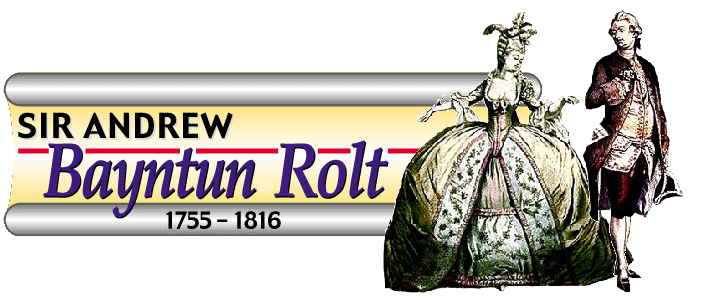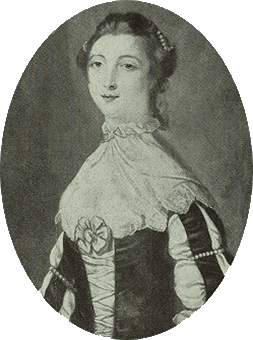Timeline
1756-1763:
The beginning of the “Seven
Year War” between Britain and France.
1760:
George II, who reigned for
33 years, died suddenly at Kensington Palace, at the age of 76, on 25th
October and was buried at Westminster Abbey, Middlesex. He was succeeded
by his 22 year old grandson, George III, the son of Frederick Louis,
Prince of Wales. The new King reigned for 60 years but was plagued by
ill-health in his later years. His long reign spanned through most of
the “Industrial Revolution” period.
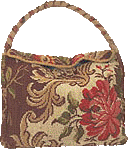
|

Sir
Andrew Bayntun Rolt fathered 21 children in all – but failed to
produce a legitimate male heir and the Baronetcy of one of Wiltshire's
families became extinct
|
Married:
LADY MARIA ALICIA COVENTRY
The daughter of The Right Honorable George William,
the 6th Earl of Coventry of Croome Court and his wife
Maria Gunning, the daughter of John Gunning of Castle
Coote, County Roscommon, Ireland.
The
marriage took place at her father's city residence,
Coventry House, in Piccadilly, London, on the
28th June,1777.
Children
from first marriage:
MARIA BARBARA BAYNTUN ROLT
(Second daughter and heiress 1780 - 1870)
MARY (First
child – died in infancy 1778)
Lady Maria
Alicia Coventry (pictured right)
|
|
Sir Andrew's
second wife was:
ANNA MARIA MAUDE
They were married in London
on the 18th May 1787 at St. Botolph, Aldergate. She was the daughter of John Maud of Bath and the ceremony was conducted by Andrew's uncle, the Reverend
John Bayntun, the Rector of Charlinch.
|
Children from second marriage
HARRIET MARIA POYNTER
LUCY BAYNTUN (19/2/1791 - 32/7/1837)
ANN BAYNTUN (11/3/1792 - 18/3/1805)
HARRIET BAYNTUN (born 19/2/1793)
EDWARD BAYNTUN (26/2/1795 - 17/3/1795
MARY BAYNTUN (14/4/1796 - 1826)
ANDREW BAYNTUN (born 1797)
EDWARD THOMAS BAYNTUN (26/6/1798 - 1868)
JOHN BAYNTUN (born 28/12/1799 - 26/1/1801)
SALLY ROSALIE BAYNTUN (28/1/1801 - 20/10/1801)
ELIZABETH BAYNTUN (20/11/1802 - 1/6/1809)
JOHN CHARLES BAYNTUN (10/1/1805 - 6/7/1830)
HENRY BAYNTUN (2/31807 - 10/6/1808)
MARIA CONSTANCIA BAYNTUN (born 13/4/1808)
Children of second illegitimate family
ANN POWER
of Lambridge, Co. Sommerset
WILMOT ROBERT BAYNTUN POWER (7/9/1801 - 28/2/1889)
CHARLES BAYNTUN POWER (born 24/11/1802)
MARTHA BAYNTUN POWER (21/3/1804 - 30/12/1881)
ANN BAYNTUN POWER (27/11/1808 - 1/4/1858)
FRANCIS BAYNTUN POWER (12/1/1809 - 28/9/1878)
GEORGE BAYNTUN POWER (2/3/1810 - 23/8/1888)
|
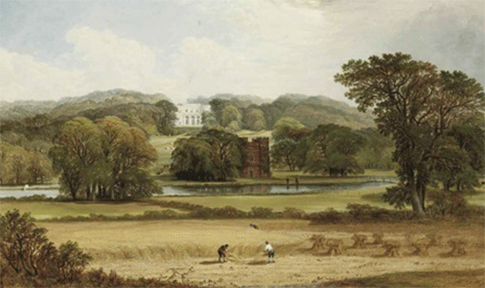
A view of the countryside and grounds at Spye Park with the Bayntun mansion in the background. Painted in 1863 and showing the short-lived castellated tower by the lake in the foreground.
|
|

Andrew
Bayntun Rolt was born on 28th September 1755 at Spye
Park House, in the county of Wiltshire. He was the
fourth son of Sir Edward Bayntun Rolt.
Sir
Edward and his wife, Dame Mary Poynter, had seven children prior to
this, but the first six, born before 1752 were considered illegitimate
when the law changed that year, declaring marriage by custom and repute
to be illegal. This meant that neither of Sir Edward's three sons could
be regarded as a legal heir in the event of his death, so he and his
wife remarried in secret. Their
seventh child was a daughter, before the birth of Andrew some years
later in 1755, which gave Sir Edward his rightful and legal heir.
On
the 28th June 1777 Andrew Bayntun Rolt married The Right Honourable
Lady Maria Alicia Coventry, who was the eldest daughter of The Right
Honourable, George William, the 6th Earl of Coventry. This marriage
took place at her father's house in Piccadilly, in the Parish of St.
George, Hanover Square and was performed by the Rev. St. Andrew St.
John, clerk, a priest or member in holy orders of the Church of England,
by virtue of a special licence granted for that purpose, by his Grace,
the Archbishop of Canterbury.
The couple had first met and became acquainted a year earlier and were
both 21 years of age at the time of their marriage. The witnesses who
signed the marriage certificate were The Earl of Coventry, Sir Edward
Bayntun Rolt (Andrew's father), Anne Coventry, William Harris and John
Coventry.
|
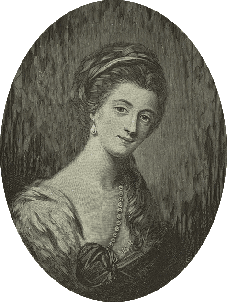
|
Maria Alicia's
mother, Lady Maria Coventry, was one of the Gunning sisters,
of Castle Coote, Roscommon, Ireland, who became famous for their
success in finding aristocratic husbands. She was a noted 18th
century beauty and a lady of fashion. Ironically it was her
beauty that eventually led to her death on 30th September 1760,
when she suffered lead poisoning from cosmetic make-up. She
was just 27 years old and it is said that over 10,000 people
viewed her coffin.
Print
Collection, Miriam and Ira D. Wallach Division of Art, Prints
and Photographs, The New York Public Library, Astor, Lenox and
Tilden Foundations.
|
Some years earlier,
Lady Coventry had an altercation with a certain Kitty Fisher, one of
the most famous 18th century courtesans, known for her beauty and wit,
and the mistress of several well-known men of the day, including Maria's
husband, the Earl of Coventry and probably Casanova. Kitty maintained
a certain rivalry with the Earl's wife and when they met in a London
park, Lady Coventry admired her dress and asked her the name of her
dressmaker. Kitty replied that she had better ask Lord Coventry as he
had given it to her as a gift.
Lady Coventry called her an impertinent woman, but Kitty answered that
her marrying a nutty Lord had put enough social difference between them
that she would have to withstand the insult. But that she was going
to marry one herself just to be able to answer back to her.
On the 30th June 1777, two days after their marriage, Maria Alicia Bayntun
wrote a letter to her stepmother, Lady Barbara Coventry, from her new
home, Battle House, in the village of Bromham. An extract from this
letter reads: "We arrived here today by dinner time and took
a walk around the park in the company of Mrs Forster, Miss Bayntun,
Sir Edward and Mr Bayntun. I don't think it polite to write a long letter
in their company. Sir Edward and Mr Bayntun wishes to be remembered
to my father and I ask you to urge my sister Anne and my brother to
answer".
Andrew entered parliament as a Tory in 1780 and was High Sheriff of Wiltshire like his father in 1802/3.
Andrew and Maria
Bayntun's first-born daughter, Mary, died a few days after her birth,
but in 1780 they had another daughter, Maria Barbara, and the couple
made their home at Battle
House (the Dower House), situated next to
the church in Bromham village.
However Maria had an affair with Andrew's nephew, John Allen Cooper
in 1781, a 21 year old officer in the 20th Regiment of foot who had
served with his regiment in America during the War of Independence.
He was the son of his older sister, Mary (1740 - 1784), who lived at
Comberwell, two miles north of Bradford on Avon. Maria had been seeing
him regularly, in secret, for 10 months or more as he was very friendly
with the couple and resided with them for some time at Battle House.
He was a gentleman of great personal charm and attractions, and the
wife and mother forgot her two-fold duties with many stolen meetings
with her new lover. Andrew and John enjoyed riding with the hounds and
often hunted with a pack belonging to the Bayntuns. He was a Member
of Parliament for Weobly, Hertfordshire and therefore spent quite some
time in London.
The affair was
first noted at the beginning of September 1781 by Andrew's brother,
the Rev. Henry Bayntun, when he visited the house on three separate
occasions and saw the couple romping together and kissing each other.
Mary Nash, who was Lady Maria's personal maid and some of the other
servants of the house were also aware of the affair and had seen them
together on many occasions. Sir Andrew, at this time, was in London
attending Parliament.
On the 9th December, Edward Baldwyn, one of the servants at Battle House,
rode to Spye Park, the residence of Andrew's father – Sir Edward
Bayntun Rolt and acquainted him of what he and the other servants had
seen. Sir Edward asked Baldwyn to tell the same to the Rev. Henry Bayntun. Andrew arrived home from London on Monday 10th December, and complying
with Sir Edward's instructions, the Rev. Henry Bayntun, his brother,
duly informed him of the affair.
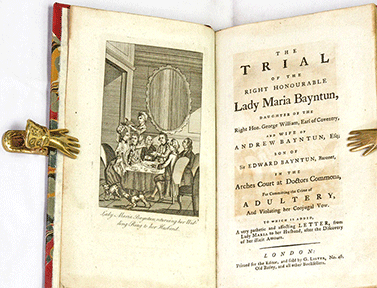
|
Later Henry was called to the drawing
room at Battle House, as was Cooper, where Andrew immediately summoned
and confronted his wife, who was pregnant at the time. He asked her
to confess to the affair, which at first she denied, but eventually
stated she had lain with Cooper on several occasions. Andrew asked her
if the child she was carrying was his or Coopers. Upon learning it was
not his, he asked for the return of her wedding ring and banished she
and Cooper from his house. Andrew and Maria never laid eyes on each
other again from that day.
A Limited Edition booklet was published some time later, outlining the account of the trial. The illustration inside the cover shows Maria handing over her wedding ring to Sir Andrew.
|
The following day, Maria sent her maid to personally deliver a letter
to Andrew. In it, she begged his forgiveness and stated that although
she had now become bitter enemies of both his mother and father, and
in their eyes a wicked woman, she pleaded with him to believe that she
would not be wicked enough to ever deceive him again and stated that
she still held a glimmer of hope that he would be hers again.
But without a reply, she and Cooper, set off from the Greyhound Inn
to his mother's house in Cumberwell where they lived together for a
short while. Nothing further is known of the baby she was carrying when
she left. Divorce was rare
at this time but on the 15th February 1783 it was granted to Andrew
Bayntun Rolt by an Act of Parliament. Andrew was, at first, inconsolable
and despite her shameless actions, he long lamented the mother of his
only child.
However
Cooper treated Maria with cruelty and brutality. The heartless destroyer
of her life and fame, finished the dismal tragedy, shutting up her corpse
in the house alone, until the rats had actually eaten part of her body.
Yet this man was afterwards admitted to the best society and admired
by all the ladies. Death at least put an end to her sufferings and the
young, elegant and accomplished Lady Maria, nurtured upon the bosom
of indulgence, died in a low house, without a single friend or attendant
to minister her last wants or a charitable hand to close her dying eyes.
She died on the 18th January 1784 at the age of 29.
|
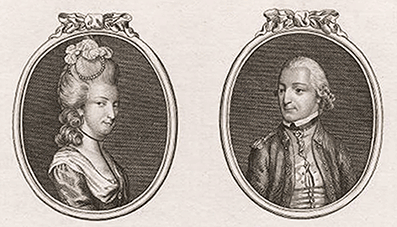
|
In a Catalogue
of Prints and Drawings in the British Museum - 1771-1783, there
is an engraving (pictured left) from The Town and Country
Magazine (1783), of two bust portraits in oval frames and an account
of the circumstances of her affair with John Allen Cooper, and
the occasion of a suit, which led to the divorce. The captions
reads: “Lady Bayntun and The Irresistible Captain”.
Unfortunately the portrait does not reflect the beauty she was.
|
In 1787 Andrew married Anna Maria Maude, but this marriage failed to
produce any children and he entered into a series of relationships that
would eventually see him father many more children. Anna Maria outlived
Andrew and died in 1827. Her will was proved at London on the 25th October
1827 and she had been living at Walcot in the County of Somerset prior
to her death.
In
1788 Andrew's father, Sir Edward Bayntun Rolt, was forced to declare
his granddaughter, Maria Barbara, first in the entail of the Bayntun
estate when she was just 8 years old, which meant she would inherit
her father's estate upon his death. The divorce meant that she would
be Andrew's only legal and legitimate heiress.
Sir
Andrew, in his early life, possessed very high moral qualities, but
the misconduct of his first wife, to whom he was fondly attracted, altered
his nature and he became a more carefree and reckless character.
He had two girlfriends – Harriet Maria Poynter who bore him 13
children and Ann Power who gave him another six – but many of these
children died young. Andrew is said to have lavished a lot of money
on his illegitimate children.
In
July 1797, Andrew's eldest daughter, Maria Barbara, eloped with the
Reverend John Starky, the Rector of Charlinch, Somerset much
to the surprise of the family.
A Roman building was first discovered by Sir Andrew Bayntun, about the
end of the 18th century, and was subsequently investigated by Sir. R.
Colt Hoare in 1810. The "dig" took place on the site, situated
in a field called West or Wyatt's Park on the old Bromham
Park estate.
Then in 1800, Andrew Bayntun Rolt inherited the Bayntun estate and the Lordship
of the Manor of Bromham, after the death of his father,
Sir Edward, and afterwards moved into Spye Park House.
He was made High Sheriff of Wiltshire in 1802 and in 1803 he sold the
Manor of Clench to Thomas Bruce, the Earl of Ailesbury. Clench had been
Bayntun property since the Dissolution of the Monasteries in 1538.
By
1806, Andrew was no longer living at Spye Park, but at Percy House,
Lower East Hayes, Bath, Somerset and was listed in a record of the appointment
of his son-in-law, the Rev. John Starky, as Rector of Charlinch, on
the 15th April 1808, as late of Spye Park, Wiltshire but now of Bathampton,
Somerset. He chose to rent the mansion at Spye Park for a number of
years.
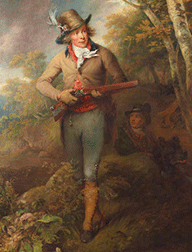
|
|
In
1808, Spye Park House was leased to Colonel Thomas Thornton, of Lincoln's Inn, Middlesex –
a gentleman much noted in the annals of sporting and racing. The lease
was for 21 years, if Sir Andrew should live so long, and included the
mansion, with a mill, a herd of deer and lands, at an annual rent of
£750. His arrival at Spye Park certainly impressed everyone with the magnificence of the Thornton establishment and a procession of wagons filled with riches such as the rural Wiltshire folk never saw before or since.
Wagons loaded with animals, luggage, guns, fishing rods, sporting gear, skins, followed by a string of thoroughbred horses each let by a groom. The
new tenant wanted to replace the Bayntun portraits in the house with
those of his own. He had an immense number of valuable
paintings and works of art, together with a collection of rare and exotic
plants and the lands were stocked with three wagon loads of bald-faced
and other red deer, roebucks, Asiatic deer and partly-coloured fallow
deer. Andrew
agreed and arranged for Henry Bayntun, probably his nephew, the Rector
of Bromham rather than his brother Harry, the Rector of Rowde and Wolverton,
to take charge of the Bayntun portraits. |
On
the 13th of September 1813, Andrew Bayntun Rolt made his last Will and
Testament, which mentioned seven of his 13 children by Harriet Maria
Poynter. The will lists the six children as Andrew, Thomas, John, Lucy,
Harriet, Maria Constance and Mary, who were all christened with the
surname Bayntun, despite the fact that Andrew was never married to Harriet
Maria. Clearly Andrew wanted these children to have his name and he
also refers to their mother in his will as Harriet Maria Bayntun, otherwise
Poynter, spinster. The other six children had died before this time
– many of them at a very young age.
A
previous Deed of Settlement dated 13th December 1809 listed another
of his reputed seven acknowledged children by the said Harriet Maria,
called Maria Constantia. The
will also lists his six children by Ann Power – Ann, Charles, Martha,
Francis, George and Wilmot Robert – all with the surname Bayntun
Power and he makes provision for them financially once they reach their
respective age of 21, or sooner should either Ann or Martha marry before
that time.
When Andrew died on 12th August 1816, the same Henry Bayntun and Sir
Andrew's daughter's husband, John Starky, argued over the paintings and
these particular portraits were never returned to Spye Park. They are
today in the possession of the Starky family in New Zealand who purchased them at that time from Henry.
Sometime in 1817, Colonel Thornton was forced to move out of Spye Park House when the lease was broken following the death of Sir Andrew Bayntun Rolt. Some time later Maria Barbara, Sir Andrew's daughter and her husband Rev. John Starky moved back into Spye Park House and resided there until the Rev. Starky died in 1834. John Edward Andrew Bayntun Starky, her son and his new wife Charlotte, moved into the Spye Park House following his father's death and Maria Barbara moved to Battle
House – the Dower House.
Six years after Andrew's death Anne Power married Robert Gomery at Walcot,
Bath, on the 17th October 1822. Gomery was an actor and singer in London
at the Old Drury Lane Theatre. One of the witnesses at this wedding
was Ann Bayntun. Andrew had bequeathed her a house at 7 Lambridge, Bath, and a good income
and she and her new husband lived there until her death in 1844. All
of her six children to Andrew Bayntun Rolt were mentioned in her will,
including
Charles Bayntun Power, whom it lists as being deceased at the time.
Anna Maria Maud died in 1827.
Andrew
Bayntun Rolt was buried in the family crypt in the Church
of St. Nicholas, Bromham. His second wife, Anna Maria
survived him and was buried at Swainswick near Bath.

|
|
A
tablet draped on a black slab in the Beauchamp Chapel in the
Church of St. Nicholas in the village of Bromham reads:
Here rest the remains of Sir Andrew Bayntun Rolt of Spye
Park, Bart, only son of the late Sir Edward Bayntun Rolt, Bart.
He married first Maria, daughter of George William Seventh
Earl of Coventry and secondly Anna Maria Maude. He
died 12th August 1816, aged 61, leaving one daughter by his
first wife.
|
Although his will acknowledged and made provision for his surviving illegitimate children, he had no surviving legitimate male issue and so his title became extinct. SPYE PARK and the remainder of his personal estate went to his only surviving legitimate child, Maria Barbara. Maria
Barbara Bayntun Rolt
|
